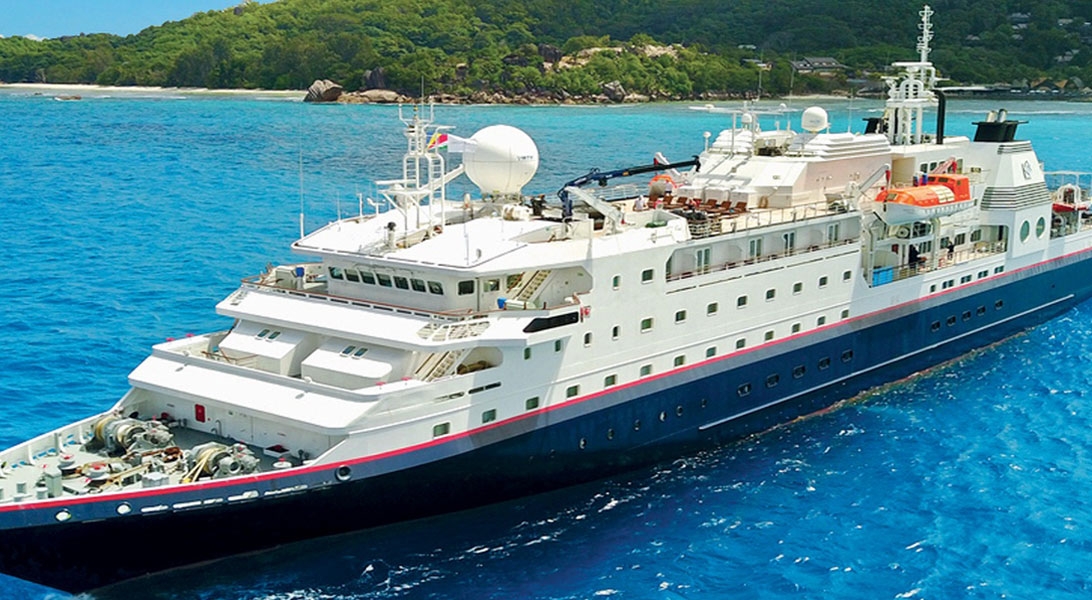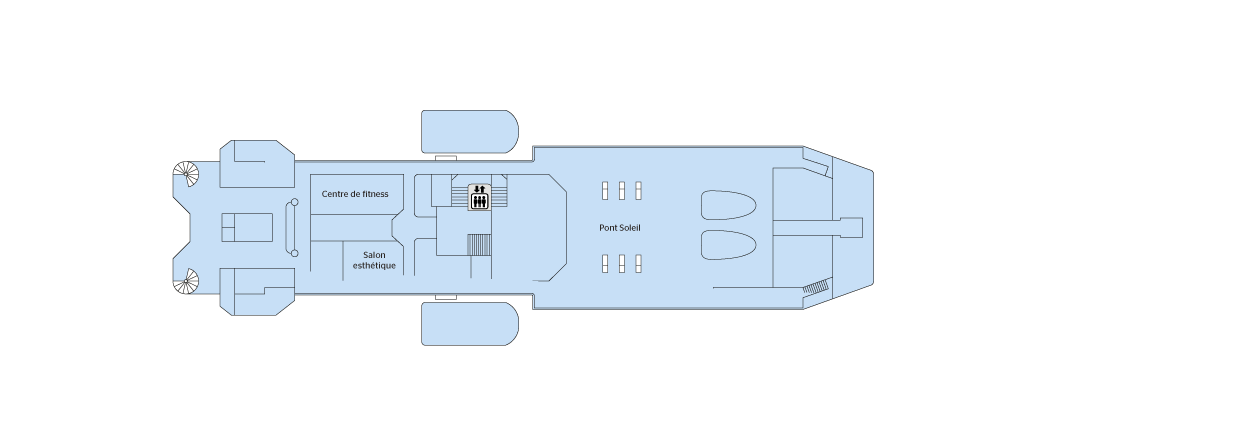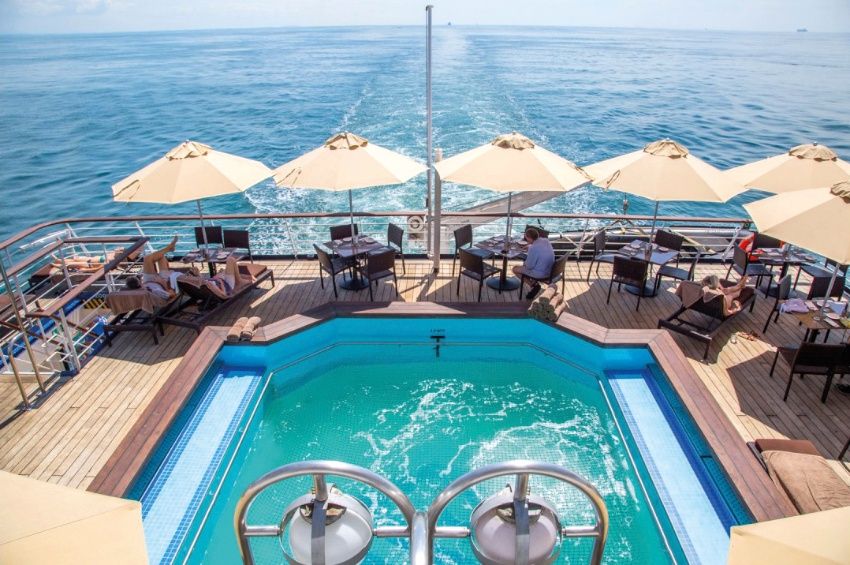This site uses cookies as defined in our Cookie Policy, by continuing to use this site you agree to their use.
Continue
| Arrive | Depart | ||||||
| 18th18 | AprApr | 202525 | Nice, France, embark on the MV La Belle des Océans | 18:00 | 18:00 | ||
United with France only since 1860, Nice has its own history and atmosphere, which dates back 230,000 years. It was on Colline du Château (now château-less) and at the Plage des Ponchettes, in front of the Old Town, that the Greeks established a market-port in 350 BC and named it Nikaia, which would become Marseilles' chief coastal rival. The Romans established themselves a little later on the hills of Cimiez (Cemenelum), already previously occupied by Ligurians and Celts, and quickly overshadowed the waterfront port. After falling to the Saracen invasions, Nice regained power as an independent state, becoming an important port in the early Middle Ages.So cocksure did it become that in 1388, Nice, along with the hill towns behind, effectively seceded from the county of Provence, under Louis d'Anjou, and allied itself with Savoie. Thus began its liaison with the House of Savoy, and through it with Piedmont and Sardinia, it was the Comté de Nice (Nice County). This relationship lasted some 500 years, tinting the culture, architecture, and dialect in rich Italian hues.By the 19th century Nice was flourishing commercially, locked in rivalry with the neighboring shipping port of Genoa. Another source of income: the dawning of tourism, as first the English, then the Russian nobility, discovered its extraordinary climate and superb waterfront position. A parade of fine stone mansions and hotels closed into a nearly solid wall of masonry, separated from the smooth-round rocks of the beach by what was originally named Camin deis Anglés (the English Way), which of course is now the famous Promenade des Anglais. This magnificent crescent, which is seeking UNESCO recognition, is one of the noblest in France. Many of Nice's most delightful attractions—the Cours Saleya market, the Old Town streets, the Hotel Negresco, and the Palais Masséna—are on or close to this 10-km (6-mile) waterfront, making it the first stop for most visitors, while the redevelopment of Nice's port, around the other side of the Colline du Château, makes it easier for amblers who want to take in the Genoese architecture or peruse the antiques at the Puces de Nice, now part of the Promenade des 100 Antiquaires, along Quai Papacino. Nice also has the distinction of the "Family Plus" label, with free strollers, play areas, and restaurants with child-friendly activities. Passengers are welcome to board at 6:00 p.m. We'll introduce our crew at a welcome cocktail. Tonight we'll enjoy dinner and an evening of activities on board. Our ship will cruise to Corsica overnight. | |||||||
| 19th19 | AprApr | 202525 | Ajaccio, Corsica, France | 12:00 | |||
Considered Corsica’s primary commercial and cultural hub, the largest city and regional capital of Ajaccio is situated on the west coast of the island, approximately 644 km (400 miles) southeast of Marseille, France. Founded in 1492, vestiges of ancient Corsica in this ville impériale revolve around the city’s most famous son, Napoléon Bonaparte, whose family home—now the national museum Maison Bonaparte—pays tribute to the emperor’s historical influence.Remnants from what was originally a 12th-century Genoese colony are still visible around the Old Town near the imposing citadel and watchtower. Perfect for exploring, the luminous seaside city surrounded by snowcapped mountains and pretty beaches offers numerous sites, eateries, side streets, and a popular harbor, where sailboats and fishing vessels moor in the picturesque Tino Rossi port lined with well-established restaurants and cafés serving fresh local fare. Our ship will begin to cruise to Corsica.In the afternoon, we offer two optional excursions:- CLASSIC: Ajaccio and the les Sanguinaires. Ajaccio, the birthplace of Napoleon Bonaparte, has a rich and historical past. Well also stop at the Pointe de la Parata, get a good glimpse of the les Sanguinaires, and stroll through this exceptional natural area.- DISCOVERY: The sights and scents of Corsica.Well cross the maquisthe Corsican underbrush exploding with a potpourri of flowers and plantsfor a visit to Corsica PAM in Ocana.An evening of Corsican music and song on board. | |||||||
| 20th20 | AprApr | 202525 | Ajaccio, Corsica, France | 22:00 | |||
Considered Corsica’s primary commercial and cultural hub, the largest city and regional capital of Ajaccio is situated on the west coast of the island, approximately 644 km (400 miles) southeast of Marseille, France. Founded in 1492, vestiges of ancient Corsica in this ville impériale revolve around the city’s most famous son, Napoléon Bonaparte, whose family home—now the national museum Maison Bonaparte—pays tribute to the emperor’s historical influence.Remnants from what was originally a 12th-century Genoese colony are still visible around the Old Town near the imposing citadel and watchtower. Perfect for exploring, the luminous seaside city surrounded by snowcapped mountains and pretty beaches offers numerous sites, eateries, side streets, and a popular harbor, where sailboats and fishing vessels moor in the picturesque Tino Rossi port lined with well-established restaurants and cafés serving fresh local fare. Today,JOIN US FOR AN OPTIONAL full-day excursion to the Calanques de Piana and the village of Porto (pre-booking only). Our coach will travel along the picturesque coastline dotted with rocky inlets until we reach Porto. We'll then jump on a local boat and head to the Calanques de Piana, where sheer cliffs and rock sculptures seem to jet up from the water and radiate a red hue along the coastline.ORThis morning,DISCOVERY package: An optional visit to the Maison Bonaparte, a national museum. The museum retraces the history of the Bonaparte family in Corsica as well as the series of exiles they experienced.This afternoon, DISCOVERY package: An optional afternoon at Mare E Sol or Capo Di Feno. At the end of the day, we'll begin to cruise to Bonifacio. We'll enjoy dinner and an evening of entertainment. | |||||||
| 21st21 | AprApr | 202525 | Bonifacio, Corsica, France | 08:00 | 18:00 | ||
Located in the South of Corsica, Bonifacio is one of the island’s most beautiful destinations. From its breathtaking views and sandy white islands to its historic citadel, the city is a must visit for anyone travelling to the island. This morning, we offer two optional excursions: - CLASSIC: Guided Tour of Bonifacio and Tasting of Craft Liquors. Bonifacio is rich with a history told along its small streets and paths, the thousand-year-old fortress, and the sturdy stone homes perched high above the sea waves. - DISCOVERY: the Lavezzi Islands nature reserve. Discover this archipelago of islets and granite reefs, as well as the sea caves and cliffs of Bonifacio.Enjoy some free time in the afternoon.In the evening, well have dinner at a traditional inn in the heart of the Corsican inland. | |||||||
| 22nd22 | AprApr | 202525 | Porto-Vecchio, France | 08:00 | 18:00 | ||
Set on a hillock overlooking a beautiful deep blue bay, Porto Vecchio, 15 miles (25km) north of Bonifacio, was rated by Scottish author James Boswell as one of "the most distinguished harbours in Europe". It was founded in 1539 as a second Genoese stronghold on the east coast, Bastia being well established in the north. The site was perfect; close to the unexploited and fertile plain, it benefited from secure high land and a sheltered harbour, although the mosquito population spread malaria and wiped out the first Ligurian settlers within months. Things began to take off mainly thanks to the cork industry, which still thrived well into the twentieth century. Today, a third of Corsica's wine is exported from Porto Vecchio, but most revenue comes from visitors. Around the centre of town explore the well-preserved fortress and the small grid of ancient streets backing onto the main place de la République. East of the square you can't miss the Porte Génoise, which frames a delightful expanse of sea and salt pans and through which you'll find the quickest route down to the modern marina, lined with cafés and hotels. This morning, we offer two optional excursions:- CLASSIC: Set out on an optional guided tour of Porto-Vecchio. The old town includes the ruins of a 16th-century citadel and gorgeous views of the marina.- DISCOVERY: An optional trip to Palombaggia Beach (with the possibility of a picnic lunch from the ship).In the late afternoon, we'll begin to cruise towards Bastia. | |||||||
| 23rd23 | AprApr | 202525 | Bastia, France | 08:00 | 18:00 | ||
Corsica's northern capital, Bastia, is the centre of commerce and industry and a thriving freight and passenger port. Commerce, more than tourism, is its main focus, providing employment for many Corsicans. Bastia's industrial sprawl, however, is offset by its aged charm. The presence of an overwhelming Italian atmosphere adds to the city's attraction. Two distinct areas comprise the city: Terra Vecchia, the old quarter, consisting of haphazard streets, flamboyant Baroque churches and lofty tenements, with their crumbling golden-grey walls set against a backdrop of fire-darkened hills; and the more orderly Terra Nova, the historic district favoured by prominent doctors, lawyers and architects. The city dates from Roman times, when a base was set up at Biguglia to the south. Under the Genoese, Bastia was the island's capital for four centuries and of major importance for the export of wine to the Italian mainland. They built a fortress (bastiglia), which gave the town its name. The Genoese also were responsible for laying the foundation for the area's prosperity by planting vines, olives, chestnut trees and other experimental crops. This resulted in an energetic and enterprising region, still a characteristic of today's northern Corsica. Although Napoleon had appointed Ajaccio the capital of the island in 1811- initiating a rivalry that still exists - Bastia established a stronger trading position with mainland France. As a result, the Nouveau Port was created in 1862 to cope with the increasing traffic with France and Italy. Bastia's economic prominence and a German division based here during World War II accounted for severe bombing attacks. Many buildings were destroyed, including much of the old governor's palace. Of the two largest towns on the island, Ajaccio and Bastia, the latter boasts a more genuine Corsican character. Visitors can experience an authentic feel of island life by wandering through the maze of narrow streets of Bastia's old quarter and by exploring its fortifications. Don't miss the vast Place Saint-Nicolas just north of the old quarter; it is the focal point of the city. Open to the sea and lined with shady trees and sidewalk cafes, it is a perfect place for people watching and for taking in the local ambiance. Pier Information The ship is scheduled to dock at the port of Bastia. The city's focal point, Place Saint-Nicolas, is a distance of 650 feet (200 metres) to walk. Taxis are generally available at the pier but it is highly recommended to book in advance if you want to be sure to get one. It is recommended to establish the fare before leaving the port. Shopping The main shopping streets, Boulevard Paoli and Rue Cesar Campinchi, are less than one half miles (500 metres) from the port terminal. Handicrafts and the area's specialties such as honey, wine and liqueurs may be of interest. Most shops are open from 9:00 a.m. to 12:00 p.m. and 2:30 p.m. to 7:00 p.m. Shops are closed for the day on Sundays and some shops may also close Monday mornings (some souvenirs shops may open Sundays during the high season of July-August). The local currency is the euro. Cuisine A variety of restaurants offer a good choice of eating possibilities. Some of the best restaurants are found around the Vieux Port and on the Quai des Martyrs. French cuisine and seafood feature prominently on menus as well as such Corsican specialties as wild boar, charcuterie and aziminu, a local version of bouillabaisse. Evidence of Bastia's strong Italian influence is apparent in the numerous pizza and pasta places in the Nouveau Port area. For outdoor dining and people watching, cafes around lively Place Saint-Nicolas are a perfect place. Other Sites Oratoire de Saint-Roch Located in the Terra Vecchia quarter, the chapel is a Genoese Baroque extravaganza built in 1604. The walls are covered with finely carved wooden panelling and the organ is magnificent with its decoration of gilt and wooden sculpture. Oratoire de L'Immaculee Conception Although its exterior is rather austere, the flamboyant interior of this 17th-century church with gilt and marble ceiling, frescoes and crystal chandeliers creates an ambiance of an opera house. Vieux Port Site of the original Porto Prado, the area around the Vieux Port is the most appealing part of town. Its soaring houses seem to bend inwards towards the water. Once busy with Genoese traders, the building of the ferry terminal and commercial docks have reduced much of the action at Vieux Port. Terra Nova As the administrative core of old Bastia, Terra Nova displays a distinct air of affluence. Its most impressive building is the 14th-century Governor's Palace. During the Genoese heyday the governor and the bishop lived here, entertaining foreign dignitaries and hosting massive parties. Private arrangements for independent sightseeing may be requested through the Tour Office on board, subject to the availability of English-speaking guides. Today, we offer an optional excursion for both packages: Cap Corse. Located to the north of Bastia and Saint-Florent, Cap Corse is a 25-mile-long promontory with several attractive fishing villages, gorgeous coastline, and a couple of good beaches.At the end of the day, we'll continue to cruise towards l'Ile-Rousse. | |||||||
| 24th24 | AprApr | 202525 | L'Île-Rousse, France | 08:00 | 18:00 | ||
“Where the mountains meet the sea,” the beautiful island of Corsica, set in the blue waters of the Mediterranean between Italy and France, is steeped in history. Ile Rousse is built on the site of an old roman settlement. She rivals Calvi as a seaside resort, with nice sandy beaches and good accommodation facilities. The port of Ile Rousse was built by Pasquale Paoli –most famous Corsican Patriot-in 1758 to replace Calvi, still in Genoese hands, has taken the place of first port in this region for exporting fresh fruit and olive oil. The harbour is located on an peninsula, red coloured rock, that just comes out of the sea hence the name of Ile Rousse which means “ reddish island”. There is a lighthouse at the outer end of the island with an old ruined tower. Returning to the mainland a street leads from port to town centre along a nice sandy beach, towards the main square Place Paoli. In the middle of the square there is a statue of Pascal Paoli. During Summer season, the square surrounded by palm trees welcomes numerous tourists looking for some shade and refreshing ice cream. The old market situated in the middle of the town, faced to the Paoli square, offers a large choice of fresh fruits and veggies as well as fish from the catch of the day, or a sample of the famous Corsican delicatessen, cheeses, honeys and wines. This morning, we offer two optional excursions:- CLASSIC: An optional tour of Calvi and its citadel. Youll discover its large marina and immense bay surrounded by unique landscapes and often snow-capped mountains.ORDiscover the old villages in the Balagne Region. These are the fertile hills of the islandcommonly referred to as the Corsican gardenswhere more than thirty villages are perched on cliffs or hidden in narrow valleys.- DISCOVERY: Kick back at Bodri or Ghjunchitu beach. Well then spend the afternoon crossing the Mediterranean to Nice. Tonight is our festive gala evening. | |||||||
| 25th25 | AprApr | 202525 | Nice, France, disembark the MV La Belle des Océans | 07:00 | |||
United with France only since 1860, Nice has its own history and atmosphere, which dates back 230,000 years. It was on Colline du Château (now château-less) and at the Plage des Ponchettes, in front of the Old Town, that the Greeks established a market-port in 350 BC and named it Nikaia, which would become Marseilles' chief coastal rival. The Romans established themselves a little later on the hills of Cimiez (Cemenelum), already previously occupied by Ligurians and Celts, and quickly overshadowed the waterfront port. After falling to the Saracen invasions, Nice regained power as an independent state, becoming an important port in the early Middle Ages.So cocksure did it become that in 1388, Nice, along with the hill towns behind, effectively seceded from the county of Provence, under Louis d'Anjou, and allied itself with Savoie. Thus began its liaison with the House of Savoy, and through it with Piedmont and Sardinia, it was the Comté de Nice (Nice County). This relationship lasted some 500 years, tinting the culture, architecture, and dialect in rich Italian hues.By the 19th century Nice was flourishing commercially, locked in rivalry with the neighboring shipping port of Genoa. Another source of income: the dawning of tourism, as first the English, then the Russian nobility, discovered its extraordinary climate and superb waterfront position. A parade of fine stone mansions and hotels closed into a nearly solid wall of masonry, separated from the smooth-round rocks of the beach by what was originally named Camin deis Anglés (the English Way), which of course is now the famous Promenade des Anglais. This magnificent crescent, which is seeking UNESCO recognition, is one of the noblest in France. Many of Nice's most delightful attractions—the Cours Saleya market, the Old Town streets, the Hotel Negresco, and the Palais Masséna—are on or close to this 10-km (6-mile) waterfront, making it the first stop for most visitors, while the redevelopment of Nice's port, around the other side of the Colline du Château, makes it easier for amblers who want to take in the Genoese architecture or peruse the antiques at the Puces de Nice, now part of the Promenade des 100 Antiquaires, along Quai Papacino. Nice also has the distinction of the "Family Plus" label, with free strollers, play areas, and restaurants with child-friendly activities. Enjoy breakfast on board this morning before disembarking at 9:00 a.m. End of our services. | |||||||






The images shown are for illustration purposes only and may not be an exact representation of what you find on the ship.
The images shown are for illustration purposes only and may not be an exact representation of what you find on the ship.

Located around the swimming pool, this restaurant offers an alternative to the other onboard catering areas. An adjoining terrace on deck 6 welcomes you to admire the magnificent landscapes.

The restaurant serves contemporary, international cuisine in a warm and elegant atmosphere. Whilst breakfast and lunch are served buffet style, dinner will be on plate service basis.
The images shown are for illustration purposes only and may not be an exact representation of what you find on the ship.
The images shown are for illustration purposes only and may not be an exact representation of what you find on the ship.
The images shown are for illustration purposes only and may not be an exact representation of what you find on the ship.
| 7 nights aboard the MV La Belle des Océans | |||
| All meals included | |||
| Drinks included with meals & at the bar | |||
| Gala dinner & evening welcome cocktail | |||
| Free Wi-Fi in lounge & bar | |||
| Headsets included for excursions | |||
| Travel Assistance & Repatriation Insurance | |||
| Port Taxes and Fees | |||
 | ABTA and ATOL Protection* | ||
Date 18th Apr 2025 |
Nts 7 |
Oceanview  |
Balcony  |
Suite £2,556pp |
Date 18th Apr 2025 |
Nts 7 |
Oceanview  |
Balcony  |
Suite £2,556pp |


| Suite staterooms from | £2,556pp | ||
| CAT2H | Horizon Suite (Deck 4) | £2,793pp | |
| CAT1H | Horizon Suite (Deck 3) | £2,556pp | |
Fusion Cruises when selling travel arrangements is a trading name of The Midcounties Co-operative Ltd. Fusion Cruises is an Accredited Body Member of Midcounties Co-operative Travel Consortium. (ABTA:P6652, ATOL:6053).
Book with Confidence. We are a Member of ABTA which means you have the benefit of ABTA’s assistance and Code of Conduct.
Some of the flights and flight-inclusive holidays on this website are financially protected by the ATOL scheme but ATOL protection does not apply to all holiday and travel services offered on this website. This website will provide you with information on the protection that applies in the case of each holiday and travel service offered before you make your booking. If you do not receive an ATOL Certificate then the booking will not be ATOL protected. If you do receive an ATOL Certificate but all parts of your trip are not listed on it, those parts will not be ATOL protected. Please see our booking conditions for information, or for more information about financial protection and the ATOL Certificate go to: www.caa.co.uk
